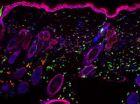(Press-News.org) Known cancer-driving genomic aberrations in localized lung cancer appear to be so consistently present across tumors that a single biopsy of one region of the tumor is likely to identify most of them, according to a paper published today in Science.
The study led by scientists at The University of Texas MD Anderson Cancer Center addresses the challenge of what scientists call genomic heterogeneity, the presence of many different variations that drive tumor formation, growth and progression, and likely complicate the choice and potential efficacy of therapy.
A landmark study of renal cell cancer in 2012 found that most cancer-promoting variations were not present across all regions of those tumors, so biopsy of a single region would not provide a good representation of cancer genes important in the genesis of any given tumor.
"An important point from our lung cancer study is that tumor heterogeneity will vary between one type of cancer and another. The pattern we found in lung adenocarcinoma is quite different than that in renal cell carcinoma," said study first author Jianjun Zhang, M.D., Ph.D. instructor in Genomic Medicine.
The researchers conducted whole exome sequencing on 48 tumor regions from 11 surgically removed localized lung adenocarcinomas, cancers that form in the epithelial tissue that lines the lung. Surgery for these non-small cell lung cancers is potentially curative.
They identified 7,269 mutations and found on average 76 percent of all mutations and 20 out of 21 known cancer gene mutations were found in all regions of the same tumor.
"This indicates that a single biopsy, sequenced at appropriate depth, may prove to be very informative regarding mutations in known cancer genes in this group of lung cancers," said paper senior author Andrew Futreal, Ph.D., professor of Genomic Medicine and holder of the Robert A. Welch Distinguished University Chair in Chemistry at MD Anderson.
Possible Connection to Relapse
Genomic heterogeneity within a tumor can be depicted as a tree structure. The trunk represents mutations present in all regions of the tumor, branches stand for mutations found in only some regions and smaller or "private" branches representing variations found only in one region.
Trunk mutations, such as the 20 cancer gene mutations the researchers found across all regions of the lung tumors, occur earlier, with branch mutations occurring later than those in the trunk.
At a median follow up of 21 months, three of the 11 patients relapsed. All three had a larger proportion of branch mutations, 40 percent, limited to a few or even one region of the tumor, compared to only 17 percent of such mutations found in those who did not relapse.
Zhang and Futreal caution that these numbers are too small to draw conclusions from; larger studies are needed to confirm the relationship between relapse and the burden of these branch mutations.
"If the correlation holds, that implies that some aspect of these branch mutations may be driving relapse, either by being a surrogate of some biological aspect of the tumor that we do not yet recognize or there being mutations occurring later that impart more aggressive characteristics, or some combination of the two," Futreal said.
The team is in the process of launching a larger study focusing on early stage lung adenocarcinomas to study the association between branch mutations and post-surgical relapse, Zhang said. Findings could lead to insights that would allow stratification of those patients at higher risk of relapse and allow for clinical trials of post-surgical drug treatment to prevent relapse. Standard of care for early stage lung cancer is surgery alone, which has 30 to 50 percent relapse rate.
INFORMATION:
Science also will publish a companion paper reaching the same conclusions led by scientists at Cancer Research UK in the United Kingdom. Futreal was at the Cancer Genome Project of the Wellcome Trust Sanger Institute before coming to MD Anderson in 2012. Futreal and longtime colleague Charles Swanton, M.D., Ph.D., of Cancer Research UK led the 2012 renal cell carcinoma study reported in the New England Journal of Medicine.
Co-authors with Futreal, Zhang and project co-leader Ignacio Wistuba, M.D., professor and chair of Translational Molecular Pathology are Junya Fujimoto, Ph.D., and Chi-Wan Chow also of Translational Molecular Pathology; Jianhua Zhang, Ph.D., Xingzhi Song, Ph.D., Sahil Seth, Harshad Mahadeshwar, Alexei Protopopov, Ph.D., Huandon Sun, and Jiabin Tang, Ph.D., of MD Anderson's Institute for Applied Cancer Science; Yu Cao, Curtis Gumbs, and Latasha Little of Genomic Medicine; Kathryn Gold, M.D., William William, M.D., John Heymach, M.D., Ph.D., and Waun Ki Hong, M.D., of Thoracic/Head and Neck Medical Oncology; Stephen Swisher, M.D., of Thoracic and Cardiovascular Surgery; J. Jack Lee, Ph.D., of Biostatistics, Jiexin Zhang of Bioinformatics and Computational Biology; Neda Khalor, M.D., and Cesar Moran, M.D., of Pathology; Xifeng Wu and Yuanquing Ye of Epidemiology; and David Wedge, Ph.D., of the Cancer Genome Project, Wellcome Trust Sanger Institute, U.K.
This research was funded by grants from the Cancer Prevention and Research Institute of Texas, The University of Texas System STARS Award, the U.S. Department of Defense, the A. Lavoy Moore Endowment Fund, the Welch Foundation and grants from the National Cancer Institute of the National Institutes of Health including the Lung Cancer Specialized Program of Research Excellence (P50CA70907) shared by The University of Texas Southwestern Medical Center and MD Anderson, MD Anderson's NCI Cancer Center Support Grant (CA016672) and the NIH T32 Research Training in Academic Medical Oncology (CA009666).
A team of scientists using the NASA/ESA Hubble Space Telescope have made the most detailed map ever of the temperature of an exoplanet's atmosphere, and traced the amount of water it contains. The planet targeted for both of the investigations was the hot-Jupiter exoplanet WASP-43b.
WASP-43b WASP-43b is a planet the size of Jupiter but with double the mass and an orbit much closer to its parent star than any planet in the Solar System. It has one of the shortest years ever measured for an exoplanet of its size -- lasting just 19 hours.
A team of astronomers working ...
COLUMBIA, Mo. – As more people in the middle of their careers decide to return to school to further their education, the number of students applying to graduate school programs across the country has reached a record high in the past decade. With record numbers of potential students applying to their programs, many graduate school admissions evaluators are working to develop stronger admissions criteria that assure they are admitting students who will succeed academically. Now, researchers at the University of Missouri have found that traditional measures such as ...
In rare cases, patients with allergies to metals develop persistent skin rashes after metal devices are implanted near the skin. New research suggests these patients may be at increased risk of an unusual and aggressive form of skin cancer.
Metal alloys help make orthopedic implants stronger and more durable. But people with sensitivity to these metals, which include nickel, cobalt and chromium, can develop chronic inflammation that promotes the development of skin cancers, report researchers at Washington University School of Medicine and Barnes-Jewish Hospital in St. ...
VIDEO:
Dr. Myron M. Levine, Director of the Center for Vaccine Development at the University of Maryland School of Medicine describes the Ebola vaccine testing taking place in Mali, West Africa.
Click here for more information.
Professor Myron M. Levine, MD, Director of the Center for Vaccine Development (CVD) at the University of Maryland School of Medicine (UM SOM), and UM SOM Dean E. Albert Reece MD, PhD, MBA, announced today that the CVD, in conjunction with its sister institution, ...
People with autism spectrum disorder often experience a period of accelerated brain growth after birth. No one knows why, or whether the change is linked to any specific behavioral changes.
A new study by UCLA researchers demonstrates how, in pregnant mice, inflammation, a first line defense of the immune system, can trigger an excessive division of neural stem cells that can cause "overgrowth" in the offspring's brain.
The paper appears Oct. 9 in the online edition of the journal Stem Cell Reports.
"We have now shown that one way maternal inflammation could result ...
Washington, DC—A new study in human placenta provides the strongest evidence to date that Endocrine Disrupting Chemicals (EDCs) can interfere with thyroid hormone action in pregnant women. The implication is that flame retardant chemicals called polychlorinated biphenyls (PCBs) can infiltrate the placenta during pregnancy and affect thyroid hormone activity at the cellular level, according to a new study published in the Endocrine Society's Journal of Clinical Endocrinology & Metabolism (JCEM).
PCBs were used in transformers and other electrical equipment, paints, ...
Washington, DC—Exposure to cold temperatures can convert white fat tissue from the thighs and belly to beige fat that burns calories for heat, but this biological response is hampered in obese people, according to a new study published in the Endocrine Society's Journal of Clinical Endocrinology & Metabolism.
Known as brown adipose tissue (BAT), brown fat is a particular kind of fat tissue that burns energy and glucose to generate heat. Babies and small animals rely on brown fat to stay warm. Brown fat's energy expenditure helps to prevent obesity in rodents.
While ...
Researchers from the National Cancer Institute report that decaffeinated coffee drinking may benefit liver health. Results of the study published in Hepatology, a journal of the American Association for the Study of Liver Diseases, show that higher coffee consumption, regardless of caffeine content, was linked to lower levels of abnormal liver enzymes. This suggests that chemical compounds in coffee other than caffeine may help protect the liver.
Coffee consumption is highly prevalent with more than half of all Americans over 18 drinking on average three cups each day ...
CAMBRIDGE, Mass--A long-sought goal of creating particles that can emit a colorful fluorescent glow in a biological environment, and that could be precisely manipulated into position within living cells, has been achieved by a team of researchers at MIT and several other institutions. The finding is reported this week in the journal Nature Communications.
The new technology could make it possible to track the position of the nanoparticles as they move within the body or inside a cell. At the same time, the nanoparticles could be manipulated precisely by applying a magnetic ...
(SALT LAKE CITY)—A University of Utah-led study using X-rays and neutron beams has revealed the inner workings of a master switch that regulates basic cellular functions, but that also, when mutated, contributes to cancer, cardiovascular disease and other deadly disorders.
Learning more about how the Protein Kinase A (PKA) switch works will help researchers to understand cellular function and disease, according to Donald K. Blumenthal, Ph.D., associate professor of pharmacology and toxicology at the University of Utah (U of U) College of Pharmacy who led the study. ...



